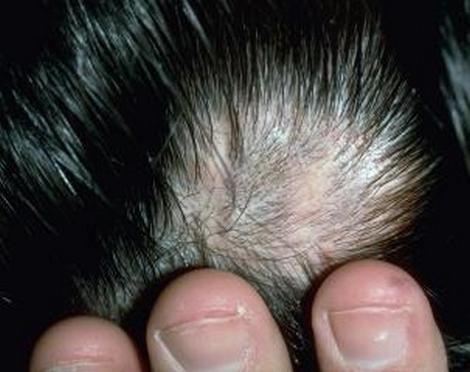Understanding Alopecia (Part I)
Alopecia is a Latin word and a general medical term that can mean either total baldness or different degrees of hair loss. Alopecia can affect people of both genders at any age, but most commonly in occurs in men and women in their mid-40s. Medical doctors distinguish several types of alopecia: androgenic alopecia, or male-pattern baldness; androgenetic alopecia, or female-pattern baldness; and alopecia areata, or patchy hair loss, which is currently believed to be an autoimmune disease of the idiopathic origin (with no known cause).
Male-pattern hair loss is a widely spread condition that affects many men over 25 years old. It is characterized by gradual thinning of the frontal part of the head, with subsequent massive loss of most, or even all, scalp hair. Experts say that male-pattern baldness is caused by a combination of genetic and hormonal factors, particularly, an overproduction of testosterone and its conversion into a toxic substance called DHT which damages healthy hair follicles and makes the hair fall out.
Androgenetic alopecia is common in women who are getting through their mid-life transition. Female-pattern hair loss can start during peri-menopause and then gradually progress causing overall thinning of scalp hair. Not all women are affected, but only those with a hereditary predisposition or severe hormonal imbalances. Underactive thyroid can also contribute to the development of androgenetic alopecia.
Alopecia areata is a relatively rare scalp and hair disorder that affects approximately one percent of the population. The disease starts suddenly by leaving bald, round or oval patches on different parts of the scalp. Their sizes can vary; in most cases, the areas of baldness are the size of a dollar coin. Alopecia areata can quickly progress and spread onto other parts of the body, including eyebrows and eyelashes. The recovery is usually spontaneous, although the condition can suddenly return later in life, after many years of remission.
What causes alopecia? The most common reasons are: ageing; sensitive hair roots; problems with the immune system; genetic predisposition; hormonal imbalances; underactive thyroid gland; physical or emotional stress; trauma; anaemia; vitamin or mineral deficiencies; malnutrition; or side effects of certain pharmaceutical medications, including radiation therapy and chemotherapy for cancer.
What are the symptoms? Alopecia can start with gradually thinning hair on top or in front of the head, a receding hair line, or bald patches anywhere on the scalp.
Can hair loss be prevented or cured? Although many cases of alopecia, especially those triggered by genetic or hormonal factors, cannot be precluded, there are medications that can slow down its development and, in some cases, re-grow some of the lost hair. Two FDA-approved drugs, Minoxidil and Finasteride, are currently used to treat male-pattern hair loss, with Minoxidil being also effective in decelerating the progression of androgenetic alopecia in women. Finasteride is a prescription drug that should be taken orally as recommended by your medical doctor; a common dosage is one tablet a day. Minoxidil comes in the form of a lotion that has to be applied topically and rubbed into the scalp in the areas of thinning hair. The results usually show only after several months of treatment and the success of applying either of these two medications is not guaranteed. Alopecia areata does not require pharmaceutical treatment since all currently existing medications show no effect in hampering its development.
Richard Dunn
Posted on July 22, 2008
Filed Under Hair Loss, Hair Loss Conditions, Hair Loss Treatments
Comments
One Response to “Understanding Alopecia (Part I)”
Leave a Reply

great info about the hair loss type. Your all the blog is very supporting of the people suffering from the hair loss problems. as hairlosscounter.com/ say that Hair loss treatment is always a big concern. It is loss of components of your body and an essential ingredient of our identity. The concern may be exaggerated in special patients groups like people in sales and young individuals seeking partners.